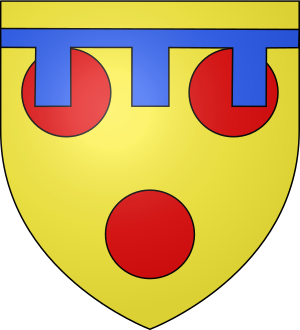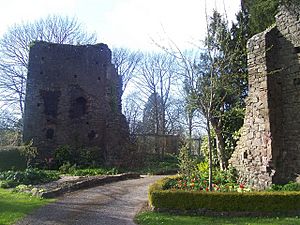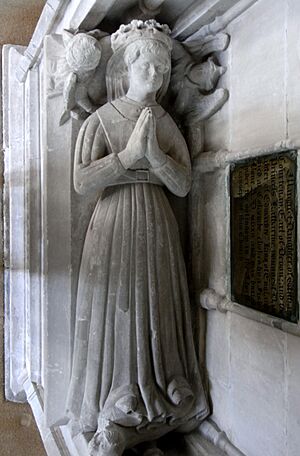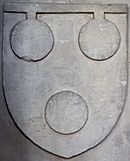Thomas de Courtenay, 5th/13th Earl of Devon facts for kids
Quick facts for kids
Thomas Courtenay
|
|
|---|---|

Arms of the Courtenay earls of Devon: Or, three torteaux a label azure
|
|
| Born | 3 May 1414 Devon, England |
| Died | 3 February 1458 (aged 43) Abingdon Abbey, Oxfordshire, England |
| Title | 5th or 13th Earl of Devon |
| Tenure | 16 June 1422 – 3 February 1458 |
| Other titles | 6th Lord Courtenay Baron of Okehampton |
| Residence | Okehampton Castle Tiverton Castle Colcombe Castle |
| Locality | Devon, Cornwall |
| Net worth | £1,516 (1422) |
| Wars and battles | Hundred Years' War Bonville–Courtenay feud • Battle of Clyst Heath Wars of the Roses • 1st Battle of St Albans (WIA) |
| Offices | Steward of the duchy of Cornwall |
| Spouse(s) | Margaret Beaufort |
| Issue more... |
Thomas, Earl of Devon John, Earl of Devon |
| House | Courtenay |
| Father | Hugh de Courtenay, 12th Earl of Devon |
| Mother | Anne Talbot |
Thomas de Courtenay, 5th/13th Earl of Devon (born May 3, 1414 – died February 3, 1458) was an important nobleman in South West England. His family, the Courtenays, had been very powerful in Devon and Cornwall for a long time.
However, other families started to gain power. This made it harder for the Courtenays to keep their top spot. Much of Thomas's life was spent fighting his neighbor, Sir William Bonville. This fight happened when the king's control over the country was weak. This local conflict was part of the bigger problems that led to the Wars of the Roses, a series of civil wars in England.
Thomas Courtenay also served in the Hundred Years' War overseas. But he focused more on making his family stronger at home. He married Margaret Beaufort when he was very young. This marriage connected him to the king's powerful Beaufort relatives.
He first supported the Beaufort party at court. But when their power faded, he joined Richard Plantagenet, 3rd Duke of York. However, York later sought help from Bonville, Courtenay's enemy. This made Courtenay lose favor with York. When the Wars of the Roses began, Courtenay sided with Queen Margaret of Anjou. He was a commander for her side at the First Battle of St Albans, where he was injured.
Thomas Courtenay died suddenly in 1458. The Wars of the Roses later led to the deaths of all three of his sons. His family's titles and lands were taken away. But the title of Earl of Devon was later given back to a distant cousin in 1485.
Contents
Early Life and Family
Thomas Courtenay was born on May 3, 1414. He was the only son of Hugh Courtenay, 4th/12th Earl of Devon and Anne Talbot. His mother was the sister of the famous warrior John Talbot, 1st Earl of Shrewsbury.
Thomas became the Earl of Devon in 1422 when he was just eight years old. He might have been looked after by Thomas Beaufort, Duke of Exeter, a very powerful man at the time.
Becoming a Knight
King Henry VI of England knighted Thomas Courtenay on May 19, 1426. Later, on December 16, 1431, Thomas was part of a large group of 300 people. They went to Paris to see King Henry VI's second coronation at Notre Dame.
Taking Control of His Lands
When Thomas grew up, he was expected to lead society in Devon. However, his mother lived a long time. This meant that some family lands, including Tiverton Castle, were not yet fully his. So, young Thomas had to live at Colcombe Castle, near Colyton. This castle was very close to his rival, William Bonville, 1st Baron Bonville, who lived at Shute. His yearly income was also lower than most nobles of his rank.
Challenges and Conflicts
Fighting with Bonville
As the new earl, Thomas found that other powerful families were gaining influence in Devon. A group of important local families, led by William Bonville, 1st Baron Bonville, challenged the Courtenays' power. Even Thomas's cousin, Sir Philip Courtenay, was part of this group.
The situation was also tricky because Bonville married Thomas's aunt in 1430. Despite his marriage to Margaret Beaufort, which linked him to the king's court, Thomas could not fix his problems. So, he started using force in 1439.
The king sent someone to make Thomas promise to behave. But Thomas still didn't want to go to court in London. In 1441, Thomas was given a job as Steward of the Duchy of Cornwall. But this job was taken away a week later. Bonville already had a similar job.
The disagreements between Thomas and Bonville became so bad that they were like a private war. Two men wearing Courtenay's colors attacked a friend of Bonville. This showed that earlier attempts to make peace had failed. Both Thomas and Bonville were called before the King in December 1441. They publicly agreed to make peace.
However, tensions remained high. The king asked both men to serve in France. Bonville went, but Thomas often refused. He seemed to prefer staying in Devon to strengthen his position. While Bonville was away, the King forgave Thomas's debts. This was likely due to the influence of his father-in-law, John Beaufort.
Royal Connections
Serving the King
Thomas's good marriage to Margaret Beaufort helped him connect with the "court party." The king started choosing him for important tasks in the West Country. He also received £100 a year for his services.
In 1445, Thomas reached a high point when he was named High Steward of England. This happened at Queen Margaret's coronation on May 25.
Changing Sides
The deaths of his brother-in-law, John Beaufort, 1st Duke of Somerset, in 1444, and Cardinal Beaufort in 1447, changed things. William de la Pole, 1st Duke of Suffolk, became the most powerful person in politics. Suffolk seemed to favor the Bonvilles. He even helped Bonville become a baron in 1449.
This likely made Thomas Courtenay oppose the "court party." He then joined his friend Richard Plantagenet, 3rd Duke of York. York briefly took control of London. Thomas stayed loyal to York. When York had to escape an angry mob in London, he took refuge on Thomas's boat on the Thames.
Thomas became known for supporting York. The country's politics were in a bad state. Thomas, who was known for being reckless, started more violence against Bonville. He also targeted James Butler, who was allied with Suffolk.
Thomas and his men tried to capture Butler. Then they went to attack Bonville at Taunton Castle. York arrived, and the two sides made a peace that didn't last. York then tried to take control of the government by force. His only allies were Thomas and Edward Brooke, 6th Baron Cobham.
In the West Country, Thomas continued to attack Bonville. York arrived and put Bonville in prison, but he was soon released. This whole event ended with Thomas and his allies having to ask for the king's mercy. The king had ordered Thomas's arrest.
Accused of Disloyalty
Thomas was accused of being disloyal to the king. He was briefly held in Wallingford Castle. Then he had to appear before the House of Lords. While he was in trouble, his rivals in Devon gained more power. Bonville got all the royal jobs in the south-west.
York's Return to Power
King Henry VI became unwell, and York was appointed as Protector in 1453-1454. This helped Thomas Courtenay. He was put back on commissions to keep the peace in the south-western counties. He was also a member of the Royal Council until April 1454.
Thomas was told to keep the peace and faced a large fine if he didn't. He ignored this. He was forced to make a new promise in July.
York Changes Allies
However, this was the end of Thomas's friendship with York. York became closer to the Neville earls, Salisbury and Warwick. This meant York now sided with Bonville, not Thomas. Bonville's grandson even married Salisbury's daughter.
Thomas did not help his standing with the Duke of Somerset either. Thomas and his sons often caused trouble at peace meetings in Exeter in 1454-1455. This made it hard for Somerset to show he could keep law and order.
Thomas was present at the First Battle of St Albans and was wounded. But York still seemed to trust him. York's letters to the King before the battle were given to the king by Thomas.
Last Attack on Bonville
After the battle, Thomas returned to Devon. He started another wave of violence against Bonville and his allies. This began in October 1455 with a terrible event. Thomas's allies violently killed Nicholas Radford, a well-known lawyer and one of Bonville's advisors.
Many people at the time were shocked by this event. Thomas's son, also named Thomas, was among those involved. Parliament reported that 800 horsemen and 4,000 foot soldiers were causing chaos across Devon.
On November 3, 1455, Thomas Courtenay and his sons, with about 1,000 men, took over the city of Exeter. Bonville was supposed to control the royal castle there, but Thomas's men held it until December 23, 1455. Thomas had warned the people that Bonville was coming to attack the city.
Bonville's men looted Thomas's house at Colcombe Castle. Bonville also promised to support Thomas's distant cousin, Sir Philip Courtenay. Many people broke into sacred places. Radford's valuables were stolen from the cathedral and his house. Villagers connected to Bonville were attacked by Thomas's men.
Powderham Castle, home to Sir Philip Courtenay, was attacked on November 15, 1455. Thomas used a cannon to try and break down its walls. Bonville tried to help the castle but was pushed back.
Finally, Bonville and Thomas fought directly at the Battle of Clyst Heath on December 15, 1455. Bonville was forced to flee. Two days later, 500 of Thomas's men looted Shute, Bonville's home. Thomas and his men left Exeter on December 21, 1455. They soon surrendered to York. The King had removed Thomas from the peace commission. Citizens of Exeter were told not to help his "army of misrule."
After the Battle
Thomas was put in the Tower of London. The government planned to try him for disloyalty. But this was dropped when King Henry VI became well again in February 1456. York was also removed as Protector.
Thomas was put back on the peace commission for Devonshire. This seemed to be the work of Queen Margaret of Anjou, who now controlled the court. Thomas had built ties with Queen Margaret. Their alliance was strengthened when his son, Sir Thomas Courtenay, married the Queen's relative, Marie.
Even though he was told not to bring armed men into Exeter, 500 men under his son, John Courtenay, entered the city on April 8, 1456. His rivals were stopped from doing their jobs as Justices of the Peace and had to leave the city. Important officials arrived to investigate. They rejected Thomas's request to remove Bonville from his sheriff job. Two years later, his sons, Thomas and Henry, were cleared of the killing of Nicholas Radford.
Thomas was put back on the list of Justices of the Peace. He was also made Keeper of the Park of Clarendon in February 1457 and Keeper of Clarendon Forest in Wiltshire in July 1457.
Marriage and Children
After 1421, Thomas de Courtenay married Lady Margaret Beaufort. She was the daughter of John Beaufort, 1st Earl of Somerset. John Beaufort was one of the four children of John of Gaunt, 1st Duke of Lancaster (son of King Edward III of England) and his wife, Katherine Swynford. Margaret's mother was Lady Margaret Holland.
Thomas and Margaret had three sons and six daughters:
- Thomas Courtenay, 14th Earl of Devon (1432 – April 3, 1461). He was captured at the Battle of Towton and executed. His earldom was then lost.
- Sir Henry Courtenay (died 1467/1469). He was executed for disloyalty.
- John Courtenay, 15th Earl of Devon (1435 – May 3, 1471). He was given back the earldom in 1470 by the Lancastrians. He was later killed at the Battle of Tewkesbury.
- Joan Courtenay (born around 1441). She married Sir Roger Clifford, and later Sir William Knyvet.
- Elizabeth Courtenay (born around 1449). She married Sir Hugh Conway.
- Anne Courtenay.
- Eleanor Courtenay.
- Maud Courtenay.
- Agnes Courtenay (1452 – January 7, 1485). She married Richard Saunders.
Monument to Margaret Beaufort
In Colyton Church, there is a small statue of a female figure. For a long time, people thought it was a young girl named Margaret Courtenay. She was said to have died from choking on a fish bone.
However, experts now believe the statue is of Margaret Beaufort (c. 1409 – 1449), Thomas de Courtenay's wife. This is based on the family symbols (heraldry) shown on the monument. The statue is much smaller than a typical adult statue.
Family Symbols (Heraldry)
Above the statue, there are three carved shields with family symbols. They show the arms of Courtenay, Courtenay combined with the royal arms of England, and the royal arms of England.
Experts believe the "royal arms" shown are actually the arms of the Beaufort family. The Beaufort arms are the royal arms of England with a special border. The statue's shields do show a border around the royal arms, which helps identify the figure as Margaret Beaufort.
Death
Thomas Courtenay was asked to meet with York and the King in London for a peace meeting. He stopped his journey at Abingdon Abbey and died there on February 3, 1458.
Some people at the time claimed he was poisoned. But this is unlikely, as he was allied with the queen at that point. In his will, Thomas asked to be buried in the Courtenay Chapel at Exeter Cathedral.
His oldest son, Thomas Courtenay, 14th Earl of Devon, became the next earl. But he was executed in 1461, and the earldom was taken away.
|








